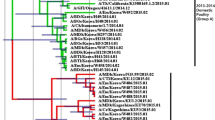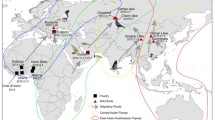Abstract
In the winter 2005/2006 H5N1 highly pathogenic avian influenza virus (HPAIV) reached Western Europe and caused numerous deaths primarily in migratory water birds. Between February and April 2006 34 cases of H5N1 HPAIV-infected dead water fowl were identified in Switzerland, almost exclusively occurring in the Lake Constance area, a large overwintering area for migratory birds in the eastern part of the country. In total, 13 of these virus isolates were genetically characterized in the present study by full-length nucleotide sequence analysis of the hemagglutinin and neuraminidase-coding region. All viruses could be confirmed as HPAIV based on the amino acid sequence of their hemagglutinin cleavage site. Phylogenetic analysis revealed that all the virus isolates were highly similar to each other and to other H5N1 strains found in neighboring countries. All analyzed Swiss virus isolates belonged to the influenza virus subclade 2.2.1.

Similar content being viewed by others
References
G.W. Wood, J.W. McCauley, J.B. Bashiruddin, D.J. Alexander, Arch. Virol. 130, 209–217 (1993). doi:10.1007/BF01319010
J.S. Peiris, M.D. de Jong, Y. Guan, Clin. Microbiol. Rev. 20, 243–267 (2007). doi:10.1128/CMR.00037-06
J.Y. Zhou, H.G. Shen, H.X. Chen, G.Z. Tong, M. Liao, H.C. Yang et al., J. Gen. Virol. 87, 1823–1833 (2006). doi:10.1099/vir.0.81800-0
A.M. Kilpatrick, A.A. Chmura, D.W. Gibbons, R.C. Fleischer, P.P. Marra, P. Daszak, Proc. Natl. Acad. Sci. USA 103, 19368–19373 (2006). doi:10.1073/pnas.0609227103
E. Starick, M. Beer, B. Hoffmann, C. Staubach, O. Werner, A. Globig et al., Vet. Microbiol. 128, 243–252 (2008). doi:10.1016/j.vetmic.2007.10.012
S. Dalessi, R. Hoop, M. Engels, Avian Dis. 51, 355–358 (2007). doi:10.1637/7580-040106R.1
C. Rutz, S. Dalessi, A. Baumer, M. Kestenholz, M. Engels, R. Hoop, Schweiz. Arch. Tierheilkd. 149, 501–509 (2007). doi:10.1024/0036-7281.149.11.501
M. Rinder, V. Lang, C. Fuchs, A. Hafner-Marx, K.H. Bogner, A. Neubauer et al., J. Vet. Diagn. Invest. 19, 279–282 (2007)
G.L. Gall-Reculé, F.X. Briand, A. Schmitz, O. Guionie, P. Massin, V. Jestin, Avian Pathol. 37, 15–23 (2008). doi:10.1080/03079450701774835
E. Spackman, D.A. Senne, T.J. Myers, L.L. Bulaga, L.P. Garber, M.L. Perdue, J. Clin. Microbiol. 40, 3256–3260 (2002). doi:10.1128/JCM.40.9.3256-3260.2002
M.J. Slomka, T. Pavlidis, J. Banks, W. Shell, A. McNally, S. Essen et al., Avian Dis. 51, 373–377 (2007). doi:10.1637/7664-060906R1.1
S. Zou, J. Clin. Microbiol. 35, 2623–2627 (1997)
K. Tamura, J. Dudley, M. Nei, S. Kumar, Mol. Biol. Evol. 24, 1596–1599 (2007). doi:10.1093/molbev/msm092
Y. Bao, P. Bolotov, D. Dernovoy, B. Kiryutin, L. Zaslavsky, T. Tatusova et al., J. Virol. 82, 596–601 (2008). doi:10.1128/JVI.02005-07
S. Weber, T. Harder, E. Starick, M. Beer, O. Werner, B. Hoffmann et al., J. Gen. Virol. 88, 554–558 (2007). doi:10.1099/vir.0.82300-0
S.L. Salzberg, C. Kingsford, G. Cattoli, D.J. Spiro, D.A. Janies, M.M. Aly, I.H. Brown, E. Couacy-Hymann, G.M. De Mia, H. Dung do, A. Guercio, T. Joannis, A.S. Maken Ali, A. Osmani, I. Padalino, M.D. Saad, V. Savić, N.A. Sengamalay, S. Yingst, J. Zaborsky, O. Zorman-Rojs, E. Ghedin, I. Capua, Emerg. Infect. Dis. 13, 713–718 (2007)
WHO/OIE/FAO H5N1 Evolution Working Group, Emerg. Infect. Dis. (2008). doi:10.3201/eid1407.071681
J.R. Happold, I. Brunhart, H. Schwermer, K.D. Stärk, Avian Dis. 52, 100–105 (2008). doi:10.1637/8021-051407-Reg
Acknowledgments
The authors would like to thank R. Hoop, Swiss National Reference Laboratory for Poultry and Rabbit Diseases, for providing the H5N1-positive samples for further analysis, and also Bernd Hoffmann and Martin Beer from the Friedrich Loeffler Institute, Island of Riems, Germany, for providing H5N1 HPAIV RNA as reference material. A. Baumer was supported by grant no. 1.07.01 from the Swiss Federal Veterinary Office (BVET).
Author information
Authors and Affiliations
Corresponding author
Rights and permissions
About this article
Cite this article
Hofmann, M.A., Renzullo, S. & Baumer, A. Phylogenetic characterization of H5N1 highly pathogenic avian influenza viruses isolated in Switzerland in 2006. Virus Genes 37, 407–413 (2008). https://doi.org/10.1007/s11262-008-0285-2
Received:
Accepted:
Published:
Issue Date:
DOI: https://doi.org/10.1007/s11262-008-0285-2




